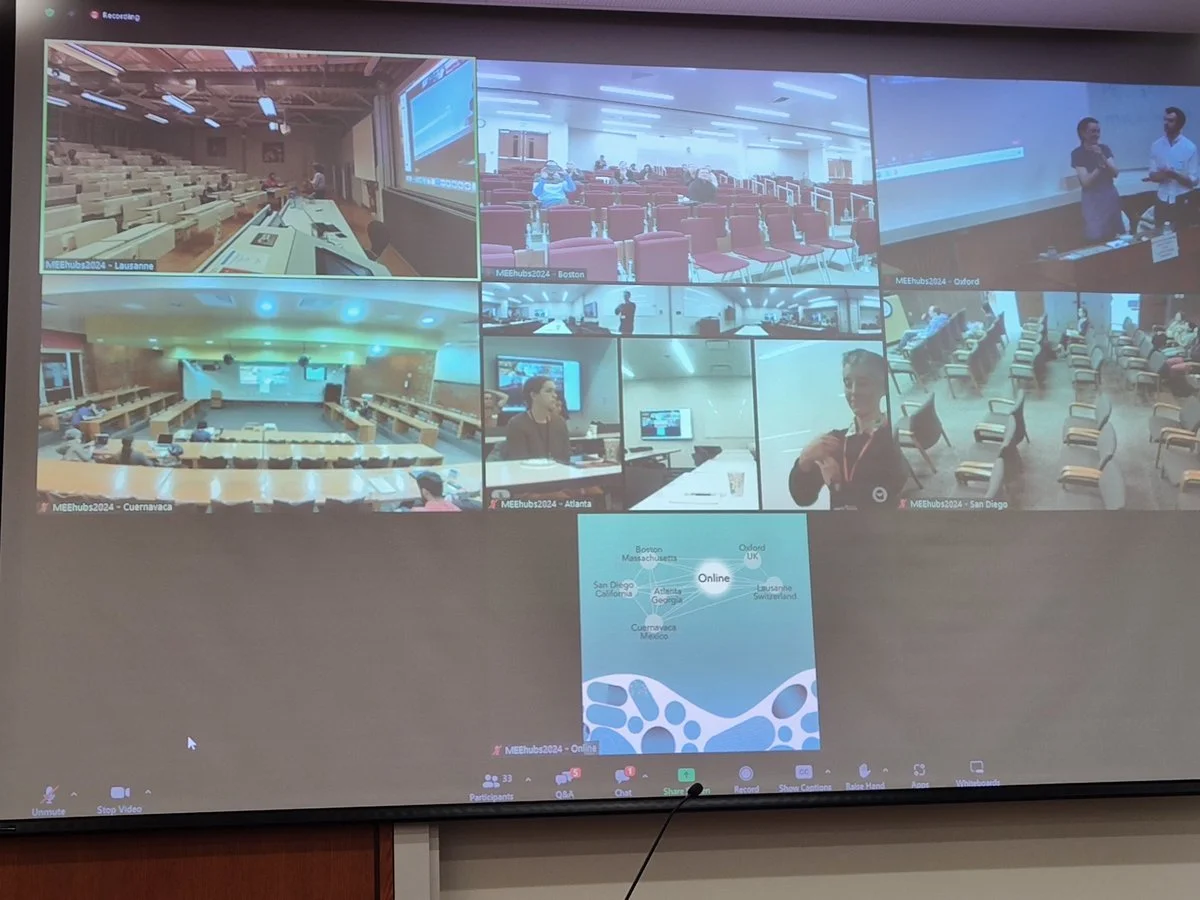Are sustainable scientific conferences possible? Featuring MEEhubs2024
A year back a group of evolutionary microbiologists organized a unique meeting on microbial ecology and evolution (MEEhubs2024) taking place simultaneously in different locations. This article delves into the key proceedings, challenges faced by organizers, and insights into the future of such conferences in light of climate concerns.
Imagine a scientific conference where researchers from around the world gather at local hubs, all connected virtually. In the post-pandemic world, this doesn’t seem an unusual idea. But for most microbiologists, MEEhubs2024 was the first such hybrid meeting combining in-person talks and online events in 6 different locations worldwide.
The locations were spread across 4 countries: Switzerland, the UK, Mexico, and the USA (in 3 cities: Boston, Atlanta, and San Diego). Participants gathered in person for posters, networking, and socializing, while online sessions featured invited speakers presenting to all hubs and all virtual participants. With hubs across multiple time zones, the event ran an intense 14–15-hour daily schedule, packed with presentations, inter-hub activities, and social events to promote broad engagement.
First Impressions
All hubs meeting virtually. Image courtesy: Prof. Babak Momeni
“We had ‘no recipe’ on how to set this multi-hub conference in motion across different time zones”, exclaims Dr. Elisa Granato, who co-organized the UK hub in Oxford. No one knew what this event would look like exactly, or how technical support would come together across different time zones. The event was initially planned for August 2023 but had to be postponed by 6 months for everything to fall in place.
Nevertheless, the novel conference format received a warm welcome from the research community and saw active participation by hundreds of researchers, making it an overall success. From notable talks about the evolution of giant viruses to how dormancy in microbes affects their evolution, the conference facilitated fascinating discussions on microbial evolution. The organizers also managed to have an equal male and female speakers ratio.
The challenge was to keep topics broad enough to encompass a diverse range of microbial researchers. One group of talks focused on how microbes evolve as collective starring mammalian gut bacteria (Sarah Knowles, the University of Oxford), human microbiota (Sur Herrera Paredes, National Autonomous University of Mexico), natural communities (Jennifer Martiny, the University of California Irvine), skin microbiota in humans (Tami Lieberman, MIT) or salamanders (Eria Rebollar, the National Autonomous University of Mexico).
Others focused on how interactions drive evolution in microbial communities, featuring opportunistic pathogens (Sam Brown, Georgia Tech), protozoan predators (Jordi van Gestel, EMBL), food fermenters (Ben Wolfe, Tufts University), and beetle microbiomes (Martin Kaltenpoth, Max Planck for Chemical Ecology)
A lot of topics dived into the breakthroughs using synthetic microbial communities, to study plant behaviors (Julia Vorholt, ETH Zurich), decipher protein complexes using deep learning complexes (Yana Bromberg, Emory University), and elucidate the evolution of cooperative mechanisms (Jeff Gore, MIT).
Some also highlighted studying microbial evolution in the realm of public health, such as predicting antibiotic resistance (Helen Alexander, University of Edinburgh), applying mathematical models to derive epidemiological inferences (Katia Koelle, Emory University), or analyzing the microbes in drinking water (Ameet Pinto, Georgia Tech).
“The presenters really enjoyed the immersive experience of the discussion. They received in-person questions, live questions from other hubs, as well as virtual interactions on the portal,” describes Prof. Sara Mitri, organizer of the Swiss hub in Lausanne.
The major hurdles
This meeting was unlike other conferences, where attendees all travel to the same location, engage in sessions in person, and meet researchers from different parts of the world. For many the main purpose of a conference is to make connections beyond the usual peers they interact with. While the in-person hubs here recreate the atmosphere of regular conferences, they still pose a big challenge for one-on-one interactions between participants in one part of the world and speakers in another.
“The Zoom platform is not set up for hub/hosting transitions. We had to find technical workarounds to make transitions between physical hubs possible, involving shifting to Zoom Pro and developing a strict workflow at each hub. Secondly, we relied on Oxford Abstracts (OA) for hosting virtual events, submissions, and registrations. It was impossible to charge registration fees to different countries via OA, leading to the decision to make the conference free of charge. This had a big effect on our budget,” explains Dr. Granato.
A participant who presented poster at Lausanne hub had this to add— “To be frank, the Oxford Abstracts system was not the most straightforward system for online interactions, as it required searching for the poster and open the comments to see if there's been any. From the comments I left on other people's posters, I've had a response in less than a fourth of them. And there was almost no time allocated for virtual interactions.”
Due to this being the first of its kind, it was also a challenge to distribute funds across hubs. Largely, the meeting was sponsored by the Swiss National Centre of Competence in Research (NCCR) Microbiomes and the Microbiology Society. Making this meeting free of charge led to a surge in last-minute cancellations and a shift toward virtual participation. As a result, on-site attendance at hubs declined, impacting the overall experience.
The heart is in the right place
A major criticism of COP climate meetings is the significant carbon footprint generated by delegates flying across the world to discuss climate reforms. What was once seen as a luxurious job perk for corporate associations and universities—traveling to conferences—is now being reconsidered in light of climate policies that demand change from everyone.
So how can the very scientists advocating for climate action shy away from taking necessary steps themselves? Many European universities are leading by example, emphasizing reduced travel and encouraging rail journeys for distances under 1,000 km.
Some scientific meetings (Society for Microbiology and Evolution- SMBE) opt for migrating conference strategy, where each time the conference takes place in different parts of the world, encouraging local participation and adding sessions that influence local scientific communities.
During the pandemic, most popular conferences shifted to fully virtual sessions. This saved many travel expenses and allowed participants from underrepresented academic corners, making the meetings more inclusive.
However, these days fully virtual conferences are least preferred— points out Ariane Wenger, who examines current virtual research practices with a focus on conferences as part of her doctoral research at ETH Zurich. In her study, she observes that while researchers acknowledge how the hybrid conference set-up can help to avoid conference air travel and reduce greenhouse gas emissions, they still had concerns regarding networking opportunities, as in-person conferences are perceived to be most suitable for informal exchange, socializing, and personal interactions.
This is where meetings like MEEhubs can make a big difference, offering a sustainable and inclusive alternative that reduces travel while maintaining the essence of in-person collaboration. Future iterations would require a better interactive platform and institutional-level organization to host hubs. Many research institutes have communication managers or science communicators who could help shape an even better event to cater to multi-faceted needs and considerations.
Another shortcoming was that while MEEhubs aspires to promote Global South participation, the current iteration faced challenges due to logistical constraints in securing local organizers in these countries. “It was not for a lack of trying. Our six hubs were finalized based on practical factors like organizer availability, accessibility (preferably by train), and the ability to attract in-person participation, across multiple time zones. Personal connections from the initiator’s professional networks also played a role in shaping these choices,” explains Dr. Wolfram Moebius from the organizing committee. Looking ahead, future iterations could focus on greater inclusion by involving scientists from Africa, Asia, and Latin America in the planning and organizational stages.
As Dr. Granato points out, “We have learned many lessons and are happy to share them with the world. We wrote a “Lessons Learned” article (published in FEMS Microbiology Letters) so that other people will have an easier time adopting and experimenting with this new format.”
We thank the MEEhub2024 organizers for speaking with us and letting us in behind the scenes. At The Experimentalists, we are eagerly looking for the next versions of this meeting. Will you be willing to participate in a multi-site conference at your local hub? Let us know your thoughts.
This article is co-written by Sandra Sánchez Barbosa.

